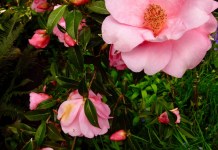Seattle leads the nation in home composting, an impressive development thanks to the City of Seattle and King County’s effort to make it easy and almost second nature for residents to do so.
According to King County, over 90 percent of single family households can now recycle food scraps in their yard waste bin, and turn last night’s pot roast and potatoes into a new main course for the garden. My people call it compost, a nutrient-rich soil amendment that helps your garden grow.
Since I live in rural King County, where yard/food waste pick-up is not available, I have to be a little more resourceful and focused to make home composting happen. Not a problem, as I’ve come up with a cheap and easy (my two favorite adjectives) way to make a worm compost bin. Once I snap some photos and find the right words to properly heap praise upon the miracle of vermiculture (worm composting), I shall share my revelations on making the right stuff, right here at home.
UPDATE: My DIY Worm Bin and Backyard Composter
In the meantime, here are some related links to get you started:
- King County: Curbside Food Scrap Collection:
- City of Seattle: How to recycle and compost videos
- Cedar Grove Compost: Turning Seattle’s yard/kitchen waste into gardening gold
 May bluebells bloom beautifully thanks to an autumn dressing of composted leaves.
May bluebells bloom beautifully thanks to an autumn dressing of composted leaves. Boz is an avid (if not haphazard) composter–here, making handy work of a bone and bed of bluebells.
Boz is an avid (if not haphazard) composter–here, making handy work of a bone and bed of bluebells.







Can’t wait to see what’s going on with your sure-to-be ingenius composting!
What an amazing photo of the bluebells. Just lovely!
Looking forward to your composting post! We too are super conscious of composting and recycling! Your bluebells are stunning – great color.
Gorgeous photo’s Tom and Boz…well, he’s definitely calendar material!
The bluebells look amazing as they encircle that grand tree.
I’ve been using bokashi food composting for about 2 years, seems to work pretty well.